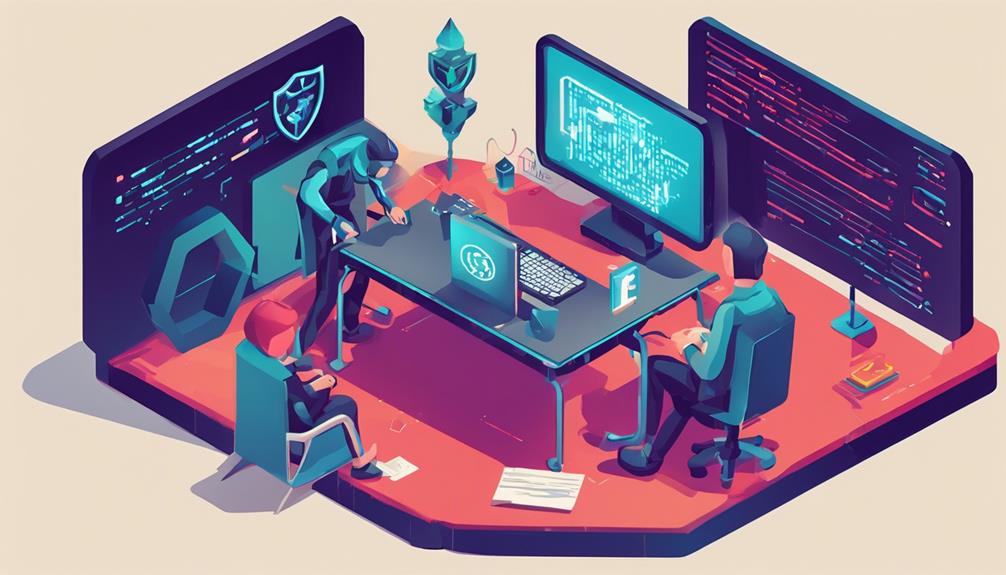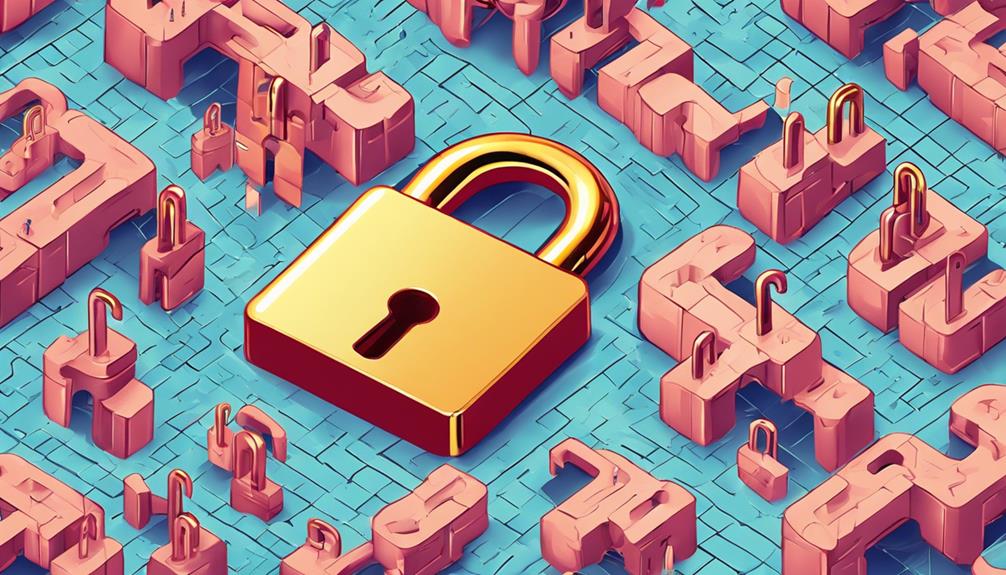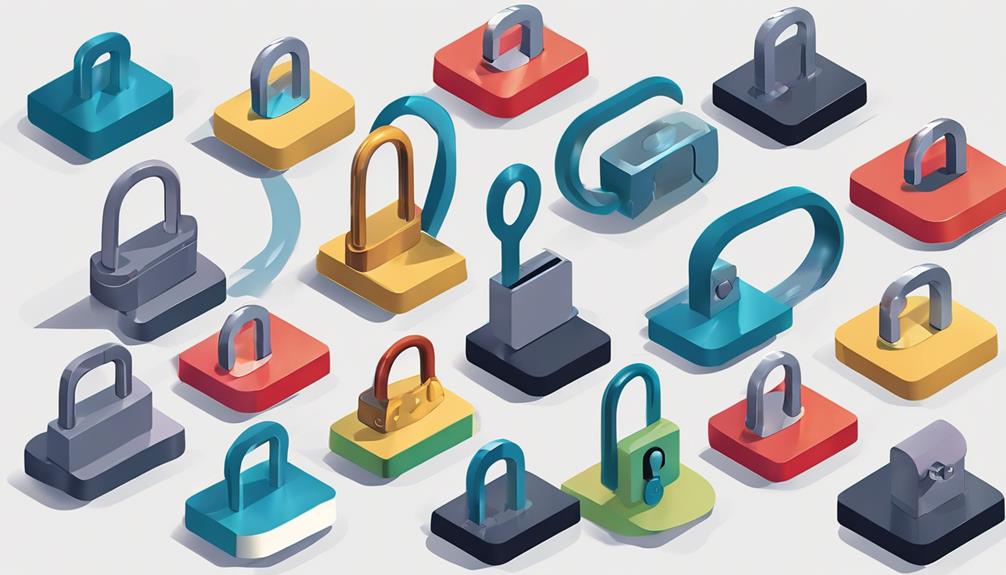To create a hack-proof password, experts recommend a strategy focusing on uniqueness and length. Use a mix of uppercase and lowercase letters, numbers, and special characters. Guarantee your password is at least 12 characters long to increase security. Avoid common phrases or easily identifiable details. Opt for a secure password manager to handle complex passwords. Educate yourself on safe password practices to safeguard personal information. Implementing multi-factor authentication with secure storage options enhances overall account security. By prioritizing these steps, you can fortify your digital accounts against potential breaches. Additional insights await for enhancing your password security.
Key Takeaways
- Use a unique password for each account to prevent widespread breaches.
- Opt for longer passwords with a mix of characters for robust security.
- Regularly update passwords to stay ahead of hacking attempts.
- Consider a password manager for secure storage and easy management.
- Implement multi-factor authentication for an extra layer of protection.
Understanding Password Security Risks
To navigate the increasingly complex landscape of cybersecurity threats, it is essential to first grasp the inherent risks associated with password security. Passwords serve as the primary line of defense against unauthorized access to sensitive information. However, the alarming statistic of one million passwords being stolen every week underscores the prevalence of security risks associated with passwords.
Phishing attacks, a common method used by cybercriminals, exploit human error to trick individuals into revealing their passwords. These attacks often lead to compromised accounts, data breaches, and financial losses for businesses. Moreover, reusing passwords across multiple platforms significantly increases the vulnerability to security breaches.
Understanding these risks highlights the importance of creating strong, unique, and regularly updated passwords to mitigate the potential impact of cyber threats. Implementing secure password management practices, such as using password managers, can provide a reliable solution for maintaining multiple complex passwords while enhancing overall cybersecurity resilience.
Common Methods of Password Hacking

Common methods of password hacking pose significant threats to cybersecurity in today's digital landscape. These methods include brute force attacks, phishing attempts, and reusing passwords.
| Common Hacking Methods | Description |
|---|---|
| Brute Force Attacks | Test different password combinations, making shorter passwords vulnerable. |
| Phishing Attempts | Use fake messages to obtain login information, often with typos or errors. |
| Reusing Passwords | Increases the risk of compromise by using the same password across multiple sites. |
Brute force attacks involve software trying thousands of passwords, targeting common words, while phishing attempts deceive users into revealing their login details. Guessing simple passwords based on commonly used information is another common hacking method. Reusing passwords across various platforms is particularly risky, as if one account is compromised, others using the same password are also at risk. To enhance cybersecurity, it is important to understand and guard against these prevalent hacking techniques.
Importance of Password Uniqueness

Amidst the evolving landscape of cybersecurity threats, emphasizing the uniqueness of passwords stands as a critical safeguard against unauthorized access and potential data breaches.
Using unique passwords for each account is not just a recommendation; it is a fundamental security measure that greatly reduces the risk of multiple accounts being compromised simultaneously.
When passwords are reused across different platforms, the vulnerability to widespread security breaches escalates, exposing sensitive personal and financial information to cyber threats.
Password uniqueness plays a pivotal role in preventing unauthorized access to confidential data. Cybercriminals specifically target reused passwords to gain entry into various accounts, paving the way for identity theft and financial loss.
By implementing unique passwords for every login, individuals can strengthen their cybersecurity defenses and deter hacking attempts effectively.
Creating hack-proof passwords requires prioritizing uniqueness to fortify the security of online accounts and personal information.
Optimal Password Length

Improving password security involves considering the ideal length for passwords, an essential aspect in safeguarding online accounts against unauthorized access. When it comes to password length, longer is better for enhanced security.
Here are some key points to remember:
- Passwords should ideally be 12 characters long or more to improve security.
- An 8-character password offers 6.6 quadrillion possible combinations, while a 12-character one provides 475 undecillion possibilities.
- Increasing the length of a password exponentially boosts security; a 16-character password yields 4.7 septillion possible combinations.
- Opt for longer passwords with a mix of random characters, numbers, and symbols to significantly fortify security against hacking attempts.
Choosing a password length that is both substantial and complex is a fundamental strategy in creating hack-proof passwords. By incorporating these guidelines, individuals can greatly reduce the risk of unauthorized access to their online accounts.
Benefits of Regular Password Changes

Regular password changes offer an essential defense mechanism against unauthorized access and potential hacking threats. Security experts recommend changing passwords every three months to prevent hacking attempts effectively.
By frequently changing your password, you hinder hackers from using old or compromised passwords to gain unauthorized access to your accounts or sensitive information.
Small to Medium-sized Businesses (SMBs) face an average cost of $384,598 per attack involving compromised passwords, highlighting the importance of regular password changes in preventing financial losses and data breaches.
Especially for shared platforms with team members, changing passwords regularly is a priority to enhance overall security measures.
While strong and uncompromised passwords may require less frequent changes to maintain security, regular password changes remain an essential practice to mitigate the risk of cyberattacks and safeguard personal and professional data from potential threats.
Implementing Password Encryption Measures

Password encryption measures involve utilizing strong encryption techniques and multi-factor authentication methods to secure sensitive data.
By encrypting passwords with robust algorithms, organizations can prevent unauthorized access and protect user information from cyber threats.
Implementing these encryption measures is essential in fortifying the security of systems and ensuring the integrity of stored passwords.
Strong Encryption Techniques
Effective encryption techniques play a pivotal role in fortifying the security of sensitive data, particularly when it comes to safeguarding passwords from potential cyber threats. Strong encryption techniques guarantee that passwords are transformed into unreadable formats, making it challenging for unauthorized individuals to access valuable information.
To achieve robust password encryption, advanced algorithms such as AES (Advanced Encryption Standard) and RSA (Rivest-Shamir-Adleman) are commonly utilized. These encryption methods not only protect passwords but also secure the underlying data, even if a breach occurs. Implementing encryption measures is fundamental in enhancing security practices, as it adds an extra layer of defense against cyber attacks.
- Password encryption transforms readable text into unreadable formats.
- Strong encryption techniques prevent unauthorized access.
- AES and RSA are advanced encryption algorithms commonly used.
- Encryption ensures data remains secure and unreadable even if passwords are compromised.
Multi-Factor Authentication Methods
To further bolster the security of sensitive data and fortify password protection, implementing multi-factor authentication methods is imperative in conjunction with robust password encryption measures. Multi-factor authentication enhances security by requiring multiple forms of verification, such as a password, a fingerprint scan, or a unique code sent to a mobile device.
This additional layer of security can prevent unauthorized access even if a password is compromised. Password encryption, on the other hand, transforms readable passwords into unreadable formats, safeguarding them from cybercriminals. By using strong encryption methods, sensitive information is stored and transmitted securely, reducing the risk of unauthorized access.
These combined strategies work together to create a more secure environment for data protection, ensuring that even if one security measure is breached, the other remains as a barrier against potential threats.
The Dangers of Writing Down Passwords

Writing down passwords poses a significant risk as it can lead to unauthorized access. When passwords are written on easily accessible mediums like sticky notes, the chances of theft increase.
To mitigate this risk, it is important to explore safe storage options and prioritize security over the convenience of memory.
Memory Vs. Security
Jotting down passwords poses a significant security risk due to the increased vulnerability to unauthorized access and potential physical theft. While it may seem convenient to write them down for memory purposes, this practice can compromise the security of your accounts and personal information.
Here are some reasons why relying on memory over written passwords is a safer option:
- Memorizing passwords reduces the risk of unauthorized access.
- Passwords stored in a password manager are more secure than those written down.
- Writing passwords on sticky notes exposes them to potential physical theft.
- 80% of hacking-related breaches involve compromised passwords, emphasizing the importance of secure password practices.
Risk of Exposure
How does the act of recording passwords on physical mediums increase the vulnerability of sensitive information to unauthorized access? When individuals write down their login credentials on paper, sticky notes, or unsecured files, they put their personal data at risk.
Over 80% of data breaches involve stolen or weak passwords, and this risk is heightened when passwords are not securely stored. Hackers can easily access written passwords, compromising the security of accounts and sensitive information.
To stay safe and protect personal data, it is recommended to avoid writing down passwords physically. Instead, utilizing secure digital storage options like password managers can greatly enhance security. Password managers not only reduce the need to write down passwords but also provide a more secure way to store and manage login credentials.
Safe Storage Options
For individuals seeking to safeguard their sensitive information, utilizing secure digital storage options is imperative in mitigating the risks associated with recording passwords on physical mediums. When it comes to safe storage options for passwords, consider the following:
- Password Managers: These tools securely store and manage all your passwords in one encrypted database, requiring you to remember only one master password.
- Secure Notes Apps: These applications offer a secure space to store passwords and other sensitive information, often with additional features like biometric authentication for added security.
- Storing Passwords Digitally: By storing passwords digitally, you reduce the risk of physical copies being lost or stolen, ensuring that your sensitive information remains protected.
- Encryption and Security: Password managers use advanced encryption techniques to safeguard your passwords, making it difficult for unauthorized individuals to access your sensitive data.
Enhancing Security With Multi-Factor Authentication

Enhancing security with multi-factor authentication is vital in safeguarding sensitive information and preventing unauthorized access to accounts. Two-factor authentication, a common form of multi-factor authentication, requires users to provide two different types of credentials to verify their identity. This typically involves something you know, like a password, and something you have, such as a phone or a security token. By combining these factors, the security of the account is greatly enhanced.
When setting up multi-factor authentication, it is important to choose strong passwords per account, incorporating a mix of uppercase and lowercase letters, numbers, and special characters. This ensures that even if one factor is compromised, the account remains secure.
Security experts recommend enabling two-factor authentication whenever possible to add an extra layer of protection beyond passwords. By implementing multi-factor authentication, users can greatly reduce the risk of unauthorized access and enhance the overall security of their accounts.
Balancing Complexity in Password Creation

Creating strong and complex passwords is essential in enhancing the security of online accounts and protecting sensitive information from unauthorized access.
When balancing complexity in password creation, consider the following:
- Mix of Uppercase and Lowercase Letters: Incorporate both uppercase and lowercase letters to increase the password's strength.
- Numbers and Special Characters: Including numbers (e.g., 123) and special characters (e.g., @#$) adds an extra layer of security.
- Recommended Length: Experts recommend passwords to be at least 12 characters long for improved protection against hacking attempts.
- Avoid Common Phrases: Refrain from using easily guessable information or common phrases, such as 'password123,' to enhance the password's strength.
Balancing complexity in password creation is essential to safeguarding personal accounts from cyber threats like dictionary attacks and brute force hacking.
Additionally, utilizing a reliable password manager can aid in generating and managing complex passwords effectively, further bolstering online security.
Safeguarding Personal Information

To safeguard your personal information, it is essential to refrain from using easily identifiable details like your name, birthdate, or social security number in your passwords.
By incorporating a combination of uppercase and lowercase letters, numbers, and symbols, you can create a more secure password that is challenging to crack.
Steer clear of common phrases or predictable information to reduce the risk of unauthorized individuals gaining access to your accounts and compromising your personal data.
Secure Personal Data
Safeguarding personal information is paramount in the digital age to minimize the risk of unauthorized access and protect sensitive data from potential breaches.
When it comes to securing personal data, there are key strategies to keep in mind:
- Avoid using personal information such as names, birthdays, or addresses in passwords to prevent easy guessing by hackers.
- Refrain from incorporating easily guessable sequences like common phrases or lyrics in your passwords to protect sensitive data.
- Create strong passphrases that are at least 12 characters long to enhance security and safeguard personal information effectively.
- Educate yourself and others on the significance of secure passwords and passphrases to strengthen your cybersecurity measures and prevent unauthorized access to personal data.
Prevent Unauthorized Access
When safeguarding personal information, the use of unique passphrases for each account is vital in preventing unauthorized access and maintaining data security.
It is essential to create passwords every account with a mix of words, numbers, and symbols to enhance security. Avoiding common or easily guessable phrases is imperative to thwart potential breaches. Ensuring that passphrases are at least 12 characters long adds an extra layer of protection against unauthorized entry.
Additionally, implementing two-factor authentication further fortifies account security by requiring a second form of verification, such as a code sent to a mobile device, in addition to the passphrase.
Frequently Asked Questions
What Is One Way a Hacker Can Get Your Password?
A hacker can obtain your password through methods like phishing, brute force attacks, or exploiting weak passwords. Using common or easily guessable passwords, and reusing them across multiple platforms, greatly increases the risk of unauthorized access.
What Is an Example of a Strong Password?
An example of a strong password would be one that includes a mix of uppercase letters, numbers, and special characters, such as 'B3@utifulD@y2023!'. It is important to avoid using personal information and common words to enhance password security.
What Password Do Most Hackers Use?
Hackers commonly exploit vulnerabilities in passwords by targeting easily guessable combinations, like dictionary words, sequential patterns, personal information, and popular phrases. To enhance security, users should avoid predictable choices and opt for complex, unique passwords.
How Do Hackers Get Admin Passwords?
Hackers often obtain admin passwords through methods like phishing, brute force attacks, and keylogging. These passwords are targeted for their high-level access to sensitive systems. Robust password policies, regular changes, and multi-factor authentication are essential defenses.
Conclusion
In the vast domain of online security, creating a hack-proof password is akin to fortifying a castle against invaders.
By understanding the risks, implementing unique and lengthy passwords, regularly changing them, avoiding written records, and utilizing multi-factor authentication, you can build a formidable defense.
Remember, the strength of your password is the key to safeguarding your digital kingdom from malicious intruders.









